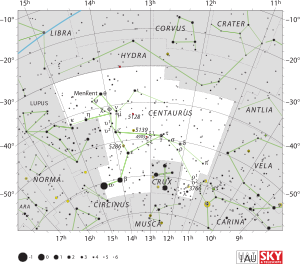| Observation data Epoch J2000.0 Equinox J2000.0 | |
|---|---|
| Constellation | Centaurus |
| Right ascension | 14h 20m 33.43s [1] |
| Declination | −37° 53′ 07.1″ [1] |
| Apparent magnitude (V) | +4.05 [2] |
| Characteristics | |
| Spectral type | A0 IV [3] (B9 and A2) [4] |
| U−B color index | −0.11 [3] |
| B−V color index | −0.03 [3] |
| Variable type | eclipsing [4] |
| Astrometry | |
| Radial velocity (Rv) | 1.8±0.9 [5] km/s |
| Proper motion (μ) |
RA: −63.69±0.18
[1]
mas/
yr Dec.: −10.65±0.15 [1] mas/ yr |
| Parallax (π) | 12.60 ± 0.20 mas [1] |
| Distance | 259 ± 4
ly (79 ± 1 pc) |
| Absolute magnitude (MV) | −0.35±0.14 [6] |
| Orbit [4] | |
| Period (P) | 38.81252±0.00029 d |
| Eccentricity (e) | 0.55408±0.00024 |
| Inclination (i) | 88.955±0.012° |
|
Argument of periastron (ω) (secondary) | 20.095±0.098° |
|
Semi-amplitude (K1) (primary) | 49.01±0.11 [7] km/s |
| Semi-amplitude (K2) (secondary) | 79.92±0.15 [7] km/s |
| Details | |
| ψ Cen A | |
| Mass | 3.114 [8] M☉ |
| Radius | 3.634 [8] R☉ |
| Luminosity | 141 [8] L☉ |
| Surface gravity (log g) | 3.811±0.003 [7] cgs |
| Temperature | 10,450 [8] K |
| Rotation | 1.49±0.26 d [4] |
| Rotational velocity (v sin i) | 123.7 [7] km/s |
| Age | 269 [6] Myr |
| ψ Cen B | |
| Mass | 1.909 [8] M☉ |
| Radius | 1.811 [8] R☉ |
| Luminosity | 18 [8] L☉ |
| Surface gravity (log g) | 4.206±0.007 [7] cgs |
| Temperature | 8,800 [8] K |
| Rotational velocity (v sin i) | 126.9 [7] km/s |
| Other designations | |
| Database references | |
| SIMBAD | data |
Psi Centauri, which is Latinized from ψ Centauri, is a binary star [10] system in the southern constellation of Centaurus. It is visible to the naked eye with a baseline apparent visual magnitude of +4.05. [2] The distance to this system is approximately 259 light years based on parallax. [1] The radial velocity is poorly constrained, but it appears to be slowly drifting away from the Sun at the rate of +2 km/s. [5]

This is a detached eclipsing binary system with the secondary eclipse being total. [4] The pair are orbiting each other with a period of 38.81 days and an eccentricity of 0.55. [10] The brightness of the system dips by 0.28 and 0.16 magnitude during the two eclipses per orbit. [4] The system displays an infrared excess at a wavelength of 60 μm, indicating the presence of a circumstellar debris disk with a temperature of 120 K, orbiting at a distance of 64 AU. [11]
The pair have a combined stellar classification of A0 IV, [3] matching a white-hued A-type subgiant. [2] The two components appear to be at different evolutionary stages. [4] Both have high rotation rates, with projected rotational velocities over 120 km/s. [7] The primary has 3.6 times the Sun's radius while the secondary is 1.8 times. [8] The primary showed evidence of pulsational behavior with 1.996 and 5.127 cycles per day, [4] which suggests it is a slowly pulsating B star. [7] But this remains unconfirmed as of 2017, [12] and the finding may instead be the result of instrumental error. [7]
References
- ^ a b c d e f van Leeuwen, F. (2007), "Validation of the new Hipparcos reduction", Astronomy and Astrophysics, 474 (2): 653–664, arXiv: 0708.1752, Bibcode: 2007A&A...474..653V, doi: 10.1051/0004-6361:20078357, S2CID 18759600. Vizier catalog entry
- ^ a b c Johnson, H. L.; et al. (1966), "UBVRIJKL photometry of the bright stars", Communications of the Lunar and Planetary Laboratory, 4 (99): 99, Bibcode: 1966CoLPL...4...99J.
- ^ a b c d Buscombe, W. (1962), "Spectral classification of Southern fundamental stars", Mount Stromlo Observatory Mimeogram, 4: 1, Bibcode: 1962MtSOM...4....1B.
- ^ a b c d e f g h i Bruntt, H.; et al. (September 2006), "Eclipsing binaries observed with the WIRE satellite. I. Discovery and photometric analysis of the new bright A0 IV eclipsing binary ψ Centauri", Astronomy and Astrophysics, 456 (2): 651–658, arXiv: astro-ph/0606551, Bibcode: 2006A&A...456..651B, doi: 10.1051/0004-6361:20065628, S2CID 16701277.
- ^ a b Gontcharov, G. A. (November 2006), "Pulkovo Compilation of Radial Velocities for 35495 Hipparcos stars in a common system", Astronomy Letters, 32 (11): 759–771, arXiv: 1606.08053, Bibcode: 2006AstL...32..759G, doi: 10.1134/S1063773706110065, S2CID 119231169.
- ^ a b Gerbaldi, M.; et al. (June 1999), "Search for reference A0 dwarf stars: Masses and luminosities revisited with HIPPARCOS parallaxes", Astronomy and Astrophysics Supplement, 137 (2): 273–292, Bibcode: 1999A&AS..137..273G, doi: 10.1051/aas:1999248.
- ^ a b c d e f g h i Mantegazza, L.; et al. (March 2010), "Spectroscopic search for g-mode pulsations in ψ Centauri", Astronomy and Astrophysics, 512: 5, Bibcode: 2010A&A...512A..42M, doi: 10.1051/0004-6361/200913013, A42.
- ^ a b c d e f g h i Eker, Z.; et al. (April 2015), "Main-Sequence Effective Temperatures from a Revised Mass-Luminosity Relation Based on Accurate Properties", The Astronomical Journal, 149 (4): 16, arXiv: 1501.06585, Bibcode: 2015AJ....149..131E, doi: 10.1088/0004-6256/149/4/131, S2CID 118740259, 131.
- ^ "psi Cen". SIMBAD. Centre de données astronomiques de Strasbourg. Retrieved 2017-06-30.
- ^ a b Eggleton, P. P.; Tokovinin, A. A. (September 2008), "A catalogue of multiplicity among bright stellar systems", Monthly Notices of the Royal Astronomical Society, 389 (2): 869–879, arXiv: 0806.2878, Bibcode: 2008MNRAS.389..869E, doi: 10.1111/j.1365-2966.2008.13596.x, S2CID 14878976.
- ^ Rhee, Joseph H.; et al. (May 2007), "Characterization of Dusty Debris Disks: The IRAS and Hipparcos Catalogs", The Astrophysical Journal, 660 (2): 1556–1571, arXiv: astro-ph/0609555, Bibcode: 2007ApJ...660.1556R, doi: 10.1086/509912, S2CID 11879505.
- ^ Liakos, Alexios; Niarchos, Panagiotis (February 2017), "Catalogue and properties of δ Scuti stars in binaries", Monthly Notices of the Royal Astronomical Society, 465 (1): 1181–1200, arXiv: 1611.00200, Bibcode: 2017MNRAS.465.1181L, doi: 10.1093/mnras/stw2756.
